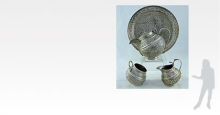
Lot
26
of
60

SILVER FROM THE INDIAN SUB-CONTINENT 1858-1947
ARTWORK DETAILS
-
-
Kashmir Circular Tray in "Coriander" Pattern
-
-
-
Silver
c.1890
Diameter: 31 cm
Weight: 617 g
-
Kashmir in northern India, located at the feet of the Himalayan mountains, is venerated in its rich canon of literature for both the beauty of its landscape and the joys of its climate. Silverware production in Kashmir was popular, however, cheaper and more easily marketable copper-work was deemed more important by the Srinagar industries. Compared to the rest of Indian regional silverware the commercial accomplishment of Kashmiri silver internationally was second only to that of Cutch silver. A distinctive feature of Kashmiri silverware is that the shape and decoration of each piece is influenced by the surrounding environment of the silversmith.
There are six main designs used to decorate Kashmiri silverware, and all are thought to echo the Persian artistic presence in Kashmir form the 17th century. These are the shawl pattern, the Chinar pattern, the poppy design, the rosette design, the mosaic pattern and the arabesque style. One of the most charming attributes of silverware from Kashmir is that one of these main design forms had to be used exclusively; the artisan often drew upon many design elements to create pieces which incorporate many or all of the above designs.
The shawl pattern, taking inspiration from the prevalent Kashmiri weaving industry, illustrates twiglets of flowers and leaves amid and between flowing scrolls; these scrolls sometimes lack detailing as to accentuate the distinction between the floral and the scroll aspects of the pattern. The Chinar pattern took inspiration from the landscape of the Kashmir Valley and comprises of stylistic illustrations of various sizes of tree leaves often attached to small branches; often the tree's fruits will also be depicted hanging from twigs. Similar to the Chinar pattern, the poppy decoration was stimulated by the abundance of poppy plants in the Kashmir Valley. Perhaps also influence by the Mughal use of poppy motifs in the adornment of many ornaments and palaces, the Kashmir poppy design featured a stylised flower form in various stages of blossoming. The rosette design consists of the leaves and flowers of the coriander plant; the relief design is organized either as an unbroken scrolling branch with small stems diverging off or organised in vertical formations. Both the mosaic pattern and the arabesque design are thought to be inspired by the configurations adorned on the great Mughal houses. The mosaic style bears resemblance to the mosaic panels covering the interior of Mughal palaces; the design features compactly arranged branches with leaves in a scrolling formation. Finally the arabesque style, in which the pattern is usually separated into orderly panels, depicts stylised illustrations of the poppy and coriander plants.
The silver used by Kashmiri silversmiths is of a high grade of purity, between 90- 98%; this makes the silver softer to work with. For this reason intricate aspects of pieces, such as the snake handles often depicting the texture of the skin, are able to be so skilfully produced.
-
Category: Jewelry
Style: Figurative
-


Height of Figure: 6'